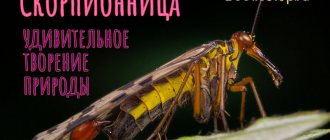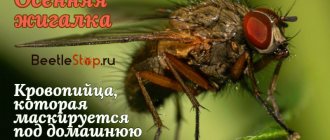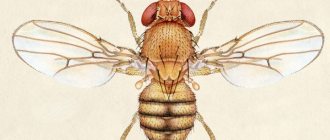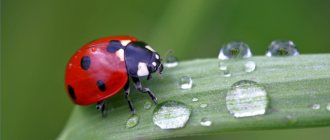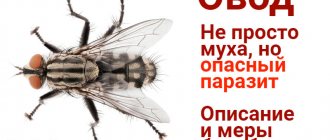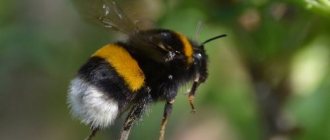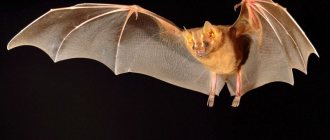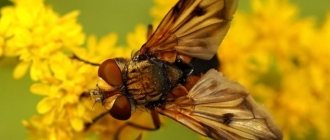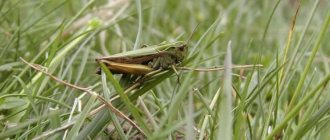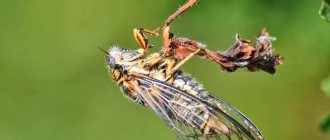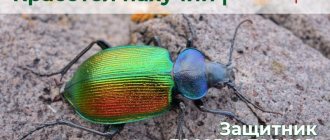Diptera, order of insects Diptera have been known in fossil form since the Late Triassic. Diptera are a progressive group with a rapid rate of evolution. They have only a front pair of wings (hence the name). The hind wings are transformed into flask-shaped organs - halteres, presumably organs of the senses of balance and direction, sometimes reduced in a few wingless forms. The head is rounded, with large compound eyes on the sides. The mouthparts are piercing-sucking or licking. The chest segments are fused together. The abdomen consists of 4-10 visible segments, the last of which are transformed in females into a telescopically retractable ovipositor, in males into a copulatory apparatus, the structure of which is a systematic (species) characteristic. Suborders; long-whiskered (or mosquitoes), short-whiskered (or flies) straight-stitched and short-whiskered round-stitched; The division is based on the structure of the antennae, head, and the characteristics of the hatching of adult individuals from the pupa shell. Diptera have over 150 modern families. About 100 thousand species, widely distributed; over 10 thousand species are known in Russia. Most adult Diptera are good flyers; They can float and hover motionless in the air.
Diptera
Diptera feed on nectar and pollen of plants, others on insects and the blood of vertebrates (gnus). Diptera have a complete transformation. Larvae live in water, soil, rotting plant debris, living plants and animals, and corpses; few, mostly carnivorous, live openly, the majority live inside the nutrient substrate, having extraintestinal digestion. The pupa of higher (round-seam) flies, as well as lionflies and gall midges, is enclosed in a lagging and hardened shell of the larva of the last (3rd) instar - the so-called. puparia, or false cocoon. A number of species of Diptera are carriers of pathogens of humans (house flies, mosquitoes, blood-sucking mosquitoes, etc.) and domestic animals (horseflies, flies, etc.). Larvae plural D. are plant pests, as well as agricultural parasites. animals and occasionally humans. Some are dipterous. useful as plant pollinators and soil formers; others, such as tachins, destroy agricultural pests.
Latin name Diptera - Diptera
The very large order of Diptera includes over 85,000 species of highly organized and specialized insects.
Diptera are insects with only a pair of membranous fore wings. Diptera are the best flyers among insects.
The hind pair of wings is reduced. Its rudiments are transformed into halteres, inside which are placed chordotonal organs, which are very important in the flight of dipterans. The wings are usually widened in the middle part, and strongly narrowed at the very base, sometimes forming a small protrusion - a wing.
Diptera are characterized by a mobile head with very large faceted eyes, a powerful chest, where the mesothorax reaches its greatest development, to which the wings are attached, and small prothorax and metathorax; sessile, sparsely stalked abdomen. The larvae are legless, with or without a head. The pupae are mobile or in a false cocoon - puparia.
General characteristics of the order Diptera
First, let's look at the classification of this type. Flies are insects from the order Diptera. All representatives of this systematic unit have only a front pair of membranous wings. The back one has turned into a haltere. These are small club-shaped structures that provide balance to the insect during flight. Fly wings have thickened anterior veins that move towards the front of the wing. This structural feature is called costalization.
You will be interested in: You will forget about boredom and laziness with riddles about deer
The body of Diptera consists of three parts - head, thorax and abdomen. Each of the six limbs consists of five segments. At the ends there are two claws with suction cups. Thanks to this structure, dipterans are able to move along steep surfaces.
You may be interested in: Colorless poisonous gases: list, symptoms of poisoning
Each of us watched as flies rubbed their limbs against each other. Why are they doing that? The fact is that taste buds are located on the lower part of the walking legs. With the help of such movements, insects clean the pads of their limbs from dirt.
Like all representatives of Diptera, the fly is an insect with complete metamorphosis. This means that its larvae are significantly different from adults. In flies they are white, mobile worms. In this case, the larvae do not have legs, but move with the help of special formations - hooks. After a few molts, the larva turns into a pupa. At this stage, an almost complete restructuring of the body occurs. As a result, the adult insect acquires new structural features compared to the larva. In addition to flies, representatives of the order Diptera include mosquitoes, tapeworms, hoverflies, gadflies, and horseflies.
Butterflies
Butterflies, or two-winged butterflies, belong to the suborder long-whiskered. In fact, these are small mosquitoes ranging in size from one to four millimeters. In appearance, they are very reminiscent of miniature and neat butterflies. There are almost three thousand species in total. Butterflies are found in all corners of the globe. Their main diversity is noticed in the CIS countries. Butterfly larvae prefer to live in rotting plant remains. Some of them prefer an aquatic environment.
The head of an adult butterfly is decorated with antennae and two eyes. Its small wings are approximately two millimeters in length. The entire body, including the wings, has a light hairy covering. Butterflies are characterized by a steel or silver color. They use their wings extremely rarely. The main method of movement is movement with the help of gusts of wind.
In total, an adult of this dipteran insect lives for two or three weeks. During her life, she usually does not eat at all. To attract a male for mating, butterflies are able to secrete a special attractive secret. It is worth noting that the bolad spider can also secrete a similar secret. This property allows him to attract male butterflies, who very often get stuck in his web.
A butterfly can lay one hundred eggs at once. And after just two days, each egg hatches into a larva. Butterfly larvae have a very important positive feature - they are able to eat mucous formations in the inside of sewer pipes. This way they clean them. Adult butterfly moths enter apartments through cracks in the floor, holes in drains, clogged drains and risers. Apartments with high humidity are the most comfortable for them.
External structure
A fly is an insect that has a typical structure for representatives of this class of animals. The body consists of three sections - head, thorax and abdomen. Six walking legs are attached to the middle one. The housefly is small in size - up to a centimeter.
On the head there is one pair of antennae, eyes and a sucking mouthparts. Therefore, the fly is not able to eat solid food. The insect searches for liquid, which it draws in using its proboscis. The fly liquefies solid substances. To do this, the insect regurgitates onto the food. It is the vomit that contains digestive enzymes that make food suitable for absorption.
Tsetse fly
He is a resident of the African continent. The food for this dangerous predator is blood from wild mammals. Flies will only be carriers of the terrifying tryponosomas.
The disease that this tryponosome causes is one of the most dangerous and incurable. They lead to death due to the destruction of the nervous and immune systems.
Sense organs
Most of the fly's head is occupied by the eyes. Each of them consists of a large number of segments - facets. For example, a housefly has about four thousand of them. Therefore, the vision of these insects is called mosaic. Thanks to this structure, the fly instantly picks up any movements. That's why she's so hard to catch.
There is also one pair of antennae on the head. With the help of these organs, the fly orients itself in space, determines the direction of movement, and distinguishes odors even at a distance of about 500 meters.
Nutrition
What do flies do and what can they eat? Very interesting, but they can be omnivores. That is why they have a high ability to feed on organic food.
If suddenly the food turns out to be too hard for them, they can soak it first. Particular preference will be given to liquid juice and liquid sweets.
Habitat
The fly, whose lifestyle we are considering in our article, belongs to the synanthropic species. This means that its existence is closely connected with man. Flies are especially interested in sewage - garbage cans, containers, rotting products, feces. It is these places that are most suitable for laying eggs, as they are rich in nutrients.
For humans, this insect poses a serious danger. The fact is that on the pads of her feet she carries the causative agents of many diseases - dysentery, cholera, typhoid fever. The difficulty also lies in the fact that harmful microorganisms are not broken down in the digestive tract, but are released outside in a viable form.
Features of development
A fly is an insect with a complete cycle of transformation, which takes place in four phases. One adult lays up to 150 eggs. Such clutches are repeated after a few days, so the total number of eggs can reach 600 eggs. They develop within a day.
The larvae are not at all similar to adult insects. These are worms without a head. They grow quickly by feeding on liquefied food. They produce it themselves by releasing digestive juices into food. This type of digestion is called extraintestinal.
After 4 days, a pupa forms from the larva. It has a hard shell called the puparium. After a certain time, this structure in the upper part bursts. This allows the adult insect to emerge. within three days the young fly lays eggs on its own. The limiting factor in this process is air temperature. When it drops below 15 degrees Celsius, the reproduction process stops.
Gadflies
There are several types of gadflies known: gastric, subcutaneous and nasopharyngeal. These are large flies that do not feed as adults, but exist due to substances accumulated during the larval period of life.
Gastric gadfly
The female gadfly lays eggs, attaching them to the fur of horses. The hatched larvae penetrate the skin, making passages in it, which causes severe itching. Horses, while combing their fur, swallow the larvae. Further development occurs in the horse's stomach. After 10 months, they leave the digestive canal, fall to the ground and pupate in the ground or manure.
Skin gadfly
The female cattle botfly lays eggs on the fur of the animal's hind legs. The larvae penetrate the skin and migrate through the tissues throughout the body, ending development under the skin of the back. Then, having left the host's body, they pupate in the soil. The skin of recovered animals has holes that devalue their skin.
Viviparous gadfly
Sheep and one type of horse gadfly are viviparous . Females fly up to the nostrils or eyes of animals and release liquid containing live larvae into them. The development of larvae occurs in the nasal and pharyngeal cavities, frontal sinuses.
Please rate the article. We tried our best:)
Diversity
In the modern period, taxonomies include about 40 thousand species of flies. The most common among them is home, or room. It is gray in color with a specific break in the wings. But the bright emerald fly, despite its visual attractiveness, is especially dangerous. This species lives exclusively on carrion and sewage.
Not all flies are associated with human life. For example, the hoverfly feeds exclusively on nectar. Outwardly, it is very similar to a wasp with transparent wings. But the fly, the description of which we will present now, is not at all a harmless creature. They call her Tsetse. This African species carries parasitic single-celled organisms called trypanosomes. They cause sleeping sickness, which is characterized by fever, weakness and unconsciousness.
So, a fly is an insect that is a representative of the Diptera order. A systematic feature is the presence of halteres. This structure is a modification of the second pair of wings, providing balance during flight. The average lifespan of flies is 20 days, and mayflies are 24 hours. Most species live near or inside human homes, feeding on human food. The negative significance of these insects is that they are carriers of dangerous diseases of humans and animals. Therefore, controlling flies and preventing their contact with food is an important requirement for hygiene.
Source
Ilnitsa bee-eater
This is not a separate species, but just a subspecies of hoverflies. With a lot of names. This is both tenacious and just ordinary. The insect will be large and the length can often be up to about 1.5 cm.
The body is predominantly dark in color. The body is also characterized by the fact that it is covered with pubescence.
The larvae themselves, if they enter the human body, often cause serious intestinal disorders.
